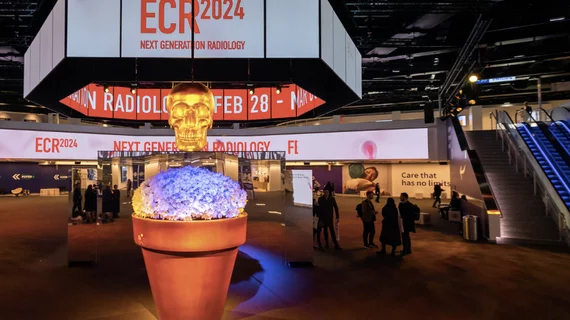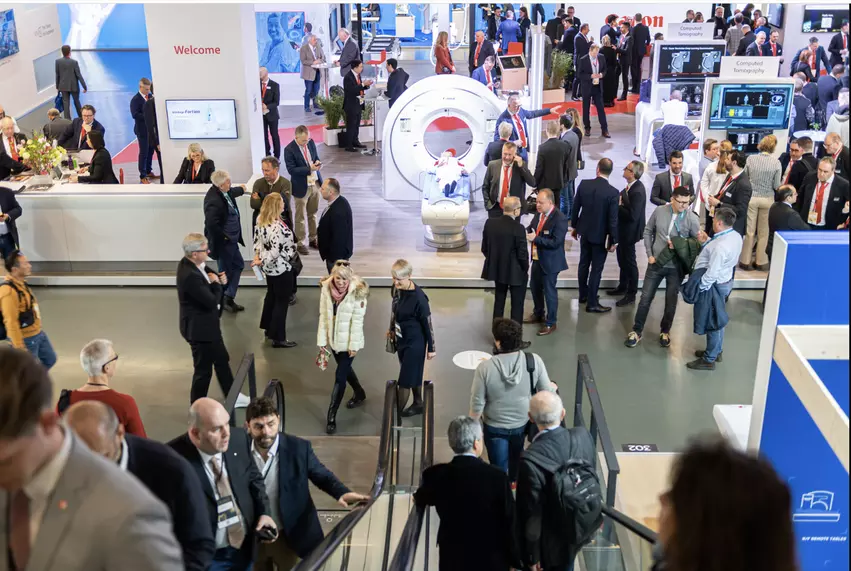Key trends in radiology at the European Congress of Radiology 2023 meeting
The European Congress of Radiology (ECR) 2023 meeting in March saw an attendance increase of 14% over ECR 2022, but it fell short of the pre-pandemic ECR headcount of just over 23,000. This increase with in-person attendance was similar to what was seen at the Radiological Society of North America (RSNA) meeting last fall. This also failed to reach pre-pandemic numbers but was a clear sign of a gradual return to normalcy. ECR had 17,262 participants from 122 countries this year.
“After all the disruptions to lives in recent years, it was wonderful to see the halls and rooms of the Austria Center crowded with busy, enthusiastic, happy attendees, enjoying all the educational and social opportunities provided by ECR 2023," said ECR 2023 Congress President Professor Adrian Brady, Mercy University Hospital, Cork Ireland, in a statement. "Onsite feedback from Congress participants was very positive, and watching attendees, I sensed that the future of radiology is in excellent hands, with young colleagues ready to continue the success and constantly-increasing clinical relevance of and delivery of value by our specialty."
Observations from the ECR show floor
The ECR industry exhibition featured more than 250 medical imaging vendors. Bhvita Jani, research manager at the healthcare market analysis firm Signify Research, attended the meeting and offered several takeaway observations.
"There was notable presence of new exhibitors on the show floor, such as Chinese vendor United Imaging, as well as an absence of conventional exhibitors, such as Shimadzu and Hologic," she said. Speculation loomed that the disappointment in attendance, as well as the revised layout from ECR 2022, could have resulted in some reluctancy from vendors to commit to taking up large booths, especially as economic headwinds continue to challenge the medical imaging market," she Jani said.
Environmental sustainability is a growing trend among radiology vendors
The global healthcare market contributes 4% of total CO2 emissions, with imaging a substantial contributor, Jani explained.
"With healthcare providers increasingly concerned about the energy crisis and environmentally sustainability, many medical imaging vendors focused their efforts on how best to decarbonize radiology," she said.
Rising energy prices, which increase operational costs for healthcare providers, resulted in modality vendors wanting to showcase new sustainability features on their imaging equipment. For example, energy saving modes on large new imaging modalities, when the systems are idle between examinations, could save up to 40% of energy consumption per scan compared to the existing fleet of installed systems, she explained. Moreover, new research initiatives were announced, including “metering” CT systems in the U.K., thereby better understanding real-world application and identifying where energy consumption could be improved.
Other themes included continued demonstrations of how healthcare providers can benefit from long-term value of their investments such as smart subscriptions, or lifetime value through long-term managed contracts, in which core system components may not require replacement. New MRI technology at the show touted up to a 70% reduction in helium consumption, Jani said. She added MRI vendors also focused on ensuring the long-term viability of coils and re-use of MRI magnets when providers upgrade to new systems. New manufacturing initiatives were also highlighted, with vendors showcasing green credentials in terms of production of equipment, design, materials and carbon-footprint.
Connected systems enable remote servicing of medical imaging equipment
On the back of a frenetic period during COVID-19, many healthcare providers have had limited time to focus on modernization strategies for radiology services, especially as pent-up demand and staff-shortages have put huge pressure on providers. Medical imaging vendors at the ECR tried to position themselves as long-term, collaborative partners, whether this be through their service offerings, ongoing training services, or strategic consulting support, Jani said.
A key theme tied to this partnership approach was “connected systems”. One foundational facet of this was supporting the ongoing shift to remote servicing of modalities. COVID accelerated the number of servicing cases done remotely, with an estimated 40% of servicing performed remotely today.
Analytics software was also shown by vendors to provides real-time monitoring of modality and staff performance across multiple sites. Jani said this is intended to help imaging service stakeholders better manage their fleets and ensure increasingly overstretched resources are deployed most effectively. Some systems included predictive tools, helping imaging service-line managers to support operational planning and better react to peaks of demand. Analytics also can help optimization by identifying patterns causing patient “no show” patients.
AI creates smarter radiology workflows
Jani said artificial intelligence (AI) continues to be integrated across the entire workflow, from examination preparation to acquisition and from reconstruction and post-processing. While much has been debated over the role of AI in post-processing and image analysis, which was also on show in the dedicated AI showcase and forum, AI was also a headline at ECR in terms of supporting and improving imaging acquisition.
Demonstrations at ECR 2023 included AI being used to track patient breathing and movement within the bore or gantry itself, use of AI to reduce scatter in X-ray imaging, and automation of patient positioning to provide consistent outcomes and deep learning reconstruction, Jani observed.
AI is being used by modality vendors to improve the quality and speed of imaging services, reducing the need for re-scans and improving the quality and safety of imaging, especially for scans requiring radiation or contrast agents. AI is increasingly being viewed by modality vendors as an important differentiator alongside the traditional hardware-based innovations, Jani said.
In particular, protocol management solutions to harmonize protocols across a fleet of systems was a prominent theme. “One-click” scan set up was also a widely touted feature of new systems.
"Typically, setting up CT and MRI systems for scans, especially more complex protocols, can take substantial technician time, sometimes as much as 15-20 minutes per scan. Leveraging information from the RIS and automated patient positioning technology, new modality workstation and on-gantry software can support much faster set-up, in many cases down to a single click. This not only saves time technicians time, but also allows scheduling scan appointments closer together, providing a tangible improvement in scan-throughput for a provider," Jani explained.
Retaining and supporting the radiology workforce healthcare providers against the backdrop of staff shortages was also a big theme for the use AI. This included examples of assistance in caseload prioritization through embedded AI at the point of care, one-click examinations or by AI powered smart protocoling. Jani said intelligent systems help limit the reliance on the operator experience or expertise.
What does the future hold for radiology?
As well as demonstration of the above across imaging product lines, medical imaging vendors are predicted to further showcase how their systems can be even more efficient, ergonomic, and intelligent this year and into RSNA, Jani said.
"AI is expected to not only proliferate in diagnostic imaging, but also in image-guided therapy applications, such as in interventional cardiology. Within the computed tomography market, photon-counting CT is expected to have strengthened further clinical validation and evidence with growing commercial traction and more installs," Jani said.
She also expects to see an increased focus from healthcare providers and vendors on screening, exemplified by the growing focus at ECR 2023. Lung screening in particular is gathering momentum in Europe, which will have substantial impact on X-ray, CT and AI industry segments in the mid-term future Jani said. Additionally, new research supporting the use of imaging and the potential of AI deployment in screening programs to not only support earlier detection of diseases, but also highlight incidental findings and early biomarkers of disease, will go a long way to reshaping the medical imaging industry in the long-term future.


